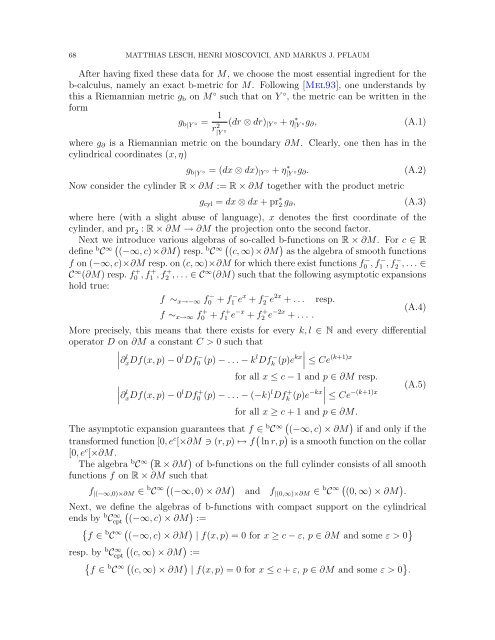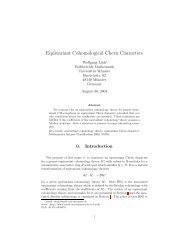Connes-Chern Character for Manifolds with Boundary and ETA ...
Connes-Chern Character for Manifolds with Boundary and ETA ...
Connes-Chern Character for Manifolds with Boundary and ETA ...
You also want an ePaper? Increase the reach of your titles
YUMPU automatically turns print PDFs into web optimized ePapers that Google loves.
68 MATTHIAS LESCH, HENRI MOSCOVICI, AND MARKUS J. PFLAUM<br />
After having fixed these data <strong>for</strong> M, we choose the most essential ingredient <strong>for</strong> the<br />
b-calculus, namely an exact b-metric <strong>for</strong> M. Following [Mel93], one underst<strong>and</strong>s by<br />
this a Riemannian metric g b on M ◦ such that on Y ◦ , the metric can be written in the<br />
<strong>for</strong>m<br />
g b |Y = 1 (dr ⊗ dr) ◦<br />
r|Y 2 |Y ◦ + η|Y ∗ ◦g ∂,<br />
(A.1)<br />
◦<br />
where g ∂ is a Riemannian metric on the boundary ∂M. Clearly, one then has in the<br />
cylindrical coordinates (x, η)<br />
g b |Y ◦ = (dx ⊗ dx) |Y ◦ + η∗ |Y ◦g ∂.<br />
Now consider the cylinder R × ∂M := R × ∂M together <strong>with</strong> the product metric<br />
g cyl = dx ⊗ dx + pr ∗ 2 g ∂ ,<br />
(A.2)<br />
(A.3)<br />
where here (<strong>with</strong> a slight abuse of language), x denotes the first coordinate of the<br />
cylinder, <strong>and</strong> pr 2 : R × ∂M → ∂M the projection onto the second factor.<br />
Next we introduce various algebras of so-called b-functions on R × ∂M. For c ∈ R<br />
define b C ( ∞ (−∞, c)×∂M ) resp. b C ( ∞ (c, ∞)×∂M ) as the algebra of smooth functions<br />
f on (−∞, c)×∂M resp. on (c, ∞)×∂M <strong>for</strong> which there exist functions f0 − , f1 − , f2 − , . . . ∈<br />
C ∞ (∂M) resp. f 0 + , f 1 + , f 2 + , . . . ∈ C ∞ (∂M) such that the following asymptotic expansions<br />
hold true:<br />
f ∼ x→−∞ f0 − + f1 − e x + f2 − e 2x + . . . resp.<br />
(A.4)<br />
f ∼ x→∞ f 0 + + f 1 + e −x + f 2 + e −2x + . . . .<br />
More precisely, this means that there exists <strong>for</strong> every k, l ∈ N <strong>and</strong> every differential<br />
operator D on ∂M a constant C > 0 such that<br />
∣<br />
∣<br />
∣∂xDf(x, l p) − 0 l Df0 − (p) − . . . − k l Df − ∣∣<br />
k (p)ekx ≤ Ce<br />
(k+1)x<br />
<strong>for</strong> all x ≤ c − 1 <strong>and</strong> p ∈ ∂M resp.<br />
∣<br />
∣<br />
∣∂xDf(x, l p) − 0 l Df 0 + (p) − . . . − (−k) l Df + ∣∣<br />
k (p)e−kx ≤ Ce<br />
−(k+1)x<br />
<strong>for</strong> all x ≥ c + 1 <strong>and</strong> p ∈ ∂M.<br />
(A.5)<br />
The asymptotic expansion guarantees that f ∈ b C ∞ ( (−∞, c) × ∂M ) if <strong>and</strong> only if the<br />
trans<strong>for</strong>med function [0, e c [×∂M ∋ (r, p) ↦→ f ( ln r, p ) is a smooth function on the collar<br />
[0, e c [×∂M.<br />
The algebra b C ∞ ( R × ∂M ) of b-functions on the full cylinder consists of all smooth<br />
functions f on R × ∂M such that<br />
f |(−∞,0)×∂M ∈ b C ∞ ( (−∞, 0) × ∂M ) <strong>and</strong> f |(0,∞)×∂M ∈ b C ∞ ( (0, ∞) × ∂M ) .<br />
Next, we define the algebras of b-functions <strong>with</strong> compact support on the cylindrical<br />
ends by b C ∞ cpt<br />
(<br />
(−∞, c) × ∂M<br />
)<br />
:=<br />
{<br />
f ∈ b C ∞ ( (−∞, c) × ∂M ) | f(x, p) = 0 <strong>for</strong> x ≥ c − ε, p ∈ ∂M <strong>and</strong> some ε > 0 }<br />
resp. by b C ∞ cpt<br />
(<br />
(c, ∞) × ∂M<br />
)<br />
:=<br />
{<br />
f ∈ b C ∞ ( (c, ∞) × ∂M ) | f(x, p) = 0 <strong>for</strong> x ≤ c + ε, p ∈ ∂M <strong>and</strong> some ε > 0 } .

















